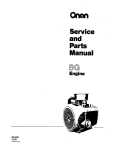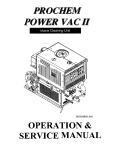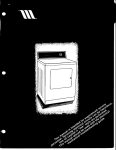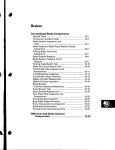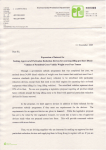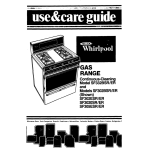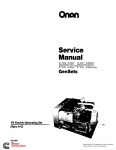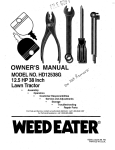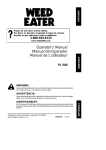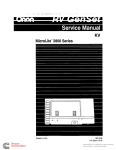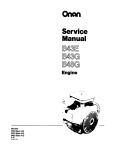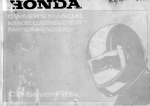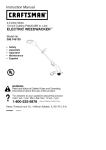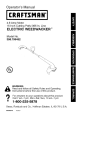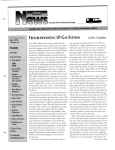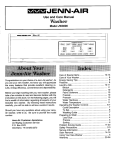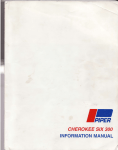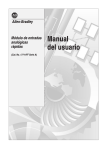Download Onan DKD Operator`s Manual - Reliable Diesel Truck and Trailer
Transcript
DKD Y Printed in USA. 981-0124 7-95 Redistribution or publication of this document by any means, is strictly prohibited. Safety Precautions Before operating the generator set, read the Operator's Manual and become familiar with it and the e ui ment. Safe and efficient operation can be achieved on y f the unit is proper1 operated and maintalned. Many accidents are caused y failure to follow fundamental rules and precautions. The following symbols,found throughoutthis manual, alert you to potentiall dangerousconditionsto the operator, servicepersonnel, or t e equipment. Thls symbol warns of immediate hazards whlch will result In severe personal Injury or death. 1-1 Thls symbolrefers to a hazard or unsafe practice whlch can result in severe personal injury or death. 9P i ; 1- Thls symbol refers to a hazard or unsafe practice whlch can result in personal Injury or product or property damage. FUELAND FUMESARE FLAMMABLE. Fire, explosion, and personal injury can result from improper practices. DO NOTfill fuel tanks while engine is running. Fuel contact with hot engine or exhaust is a potential fire hazard. DONOTSMOKEOR USEAN OPEN FLAMEnearthe generator set or fuel tank. Fuel lines must be adequately secured and free of leaks. Fuel connection at the engine should be made with an approvedflexible,non-conductiveline. Donot use copper piping on flexible lines as copper will work hardenand become brittle. Be sure all fuel supplies have a positive shutoff valve. GASOLINE AND LPG FUEL MAY BE ACCIDENTALLY IGNKEDBY ELECTRICALSPARKS, resentingthe hazardof fire or expioslon, which can resu t In severe personal lnjury or death. When installing the generator set: Do not tie electricalwiring to fuel lines. Do not run electrical lines and fuel lines through the same compartment openings. Keep electricaland fuel lines as far apart as possible. Place a physical barrier between fuel lines and electrical lines wherever possible. If electricaland fuel lines must pass through the same compartment opening, make certain that they are physically separated by running them through individual channels, or by passing each line through a separate piece of tubing. DO NOTSMOKE while servicing batteries. Lead acid batteries emit a highly explosive hydrogengas that can be ignited by electricalarcing or by smoking. EXHAUST GASES ARE DEADLY Never sleep in the vehicle with the generator set runningunless vehicle is equippedwith an operatingcarbon monoxide detector. Providean adequate exhaust system to properly expel discharged gases. inspect exhaust system daily for leaks per the maintenance schedule. Be sure that exhaust manifolds are secure and not warped. Do not use exhaust gases to heat a compartment. Be sure the unit is well ventilated. MOVING PARTS CAN CAUSE SEVERE PERSONAL INJURY OR DEATH Beforestartingwork on the generatorset, disconnectbatteries, This will prevent accidental arcing. P Keep your hands away from moving-parts. Make sure that fasteners on the generator set are secure. Tighten supports and clamps, keep guards in position over fans, drive belts, etc. Do notwear loose clothing or jewelry while working on generator sets. Loose clothing andjewelry can become caught in moving parts. Jewelry can short out electrical contacts and cause shock or burning. If adjustmentmust bemadewhiletheunit is running, use extreme caution around hot manifolds, moving parts, etc. ELECTRICALSHOCKCAN CAUSESEVERE PERSONAL INJURY OR DEATH Disconnect starting battery before removing protective shields or touching electrical equipment. Use rubber insulative mats placed on dry wood plalforms over floors that are metalor concretewhen around electricalequipment. Do not wear damp clothing(particularlywetshoes) or allow skinsurfaces to be damp when handling electricalequipment. Use extreme caution when working on electrical components. High voltages can cause injury or death. Followall state and localelectricalcodes. Have all electrical installations performed by a qualified licensed electrician. Tag open switches to avoid accidental closure. DO NOT CONNECT GENERATOR SET DIRECTLY TO ANY BUILDING ELECTRICALSYSTEM. Hazardousvoltages canflow from the generatorset intothe utility line. This creates a potential for electrocution or property damage. Connect only through an approveddevice and after building main switch is open. Consult an electrician in regard to emergency power use. GENERAL SAFETY PRECAUTIONS Haveafire extinguishernearby. Maintainextinguisherproperly and become familiar with its use. Extinguishers rated ABC by the NFPA are appropriatefor all applications. Consult the local fire department for the correct type of extinguisher for various applications. Hot coolants under pressurecan cause severe personal injury. DONOTopena radiatorpressurecap while the engine is running. Stop the engine and carefully bleedthe system pressure. Benzene and lead, foundin some gasoline, have beenidentified by some state and federal agenciesas causingcancer or reproductivetoxicity. When checking, draining or adding gasoline, take care notto ingest, breathethe fumes, or contact gasoline. Used engine oils have been identifiedby some state or federal agencies as causing cancer or reproductive toxicity. When checking or changing engine oil, take care not to ingest, breathe the fumes, or contact used oil. Removeall unnecessary grease and oil fromthe unit. Accumulated grease and oil can cause overheating and engine damage, which presents a potentialfire hazard. DO NOTstore anything in the generator compartment such as oil or gascans, oilyrags, chains, wooden blocks, portable propane cylinders, etc. A fire could result or the generator set operation (cooling, noise and vibration) may be adversely affected. Keepthecompartment floor cleanand dry. Do not work on this equipment when mentally or physically fatigued, or after consuming any alcohol or drug that makes the operation of equipment unsafe. Redistribution or publicationRV-9 of this document by any means, is strictly prohibited. Table of Contents PAGE TITLE .................................................................Inside Front Cover ................................................................................. i .......................................................................................1 .................................................................................... 1 ................................................................................ 1 ...................................................................................... 2 ........................................................................................... 3 .............................................................................................3 ................................................................................... 3 ........................................................................................ 3 ..............................................................................................4 ............................................................................................ 5 ..........................................................................5 ......................................................................................6 .........................................................................................7 .......................................................................7 ............................... .............................................. 8 .................................... ............................................... 8 ....................................... ............................................. 9 .............................................. ............................................. 10 .......................................................................................11 ........................................... ............................................. .............................................................................................13 ....................................................................................... 13 .................................................................................14 ............................................................................................. 14 ............................................................................14 SAFETY PRECAUTIONS TABLE OF CONTENTS INTRODUCTION About this Manual How to Obtain Service SPECIFICATIONS OPERATION General Pre-Start Checks., Control Panel Starting Stopping Operating Recommendations Troubleshooting MAINTENANCE Periodic Maintenance Schedule Generator Set Inspection Lubrication System Cooling System Fan Belt Fuel System Air Cleaner Battery AC Generator Crankcase Breather Muffler Out-of-Service Protection a n I I California Proposition 65 Warning Diesel engine exhaust and some of its constituents are known to the State of California to cause cancer. birth defects. and other reproductive harm . i Redistribution or publication of this document by any means, is strictly prohibited. Redistribution or publication of this document by any means, is strictly prohibited. Introduction ABOUT THIS MANUAL When contacting an Onan dealer or distributor, always supply the complete Model number and Serial number as shown on the Onan nameplate. See Figure 1. This manual provides information for operating and maintaining the Onan DKD generator set. Study this manual carefully and observe all warnings and cautions. Using the generator set properly and following a regular maintenance schedule will result in longer unit life, better performance, and safer operation. The Onan nameplate is located on the side of the generator control box on the 7.5 DKD, 6.5 DKD, and 6.0 DKD, and is located on the side of the belt guard on the 8.0 DKD. HOW TO OBTAIN SERVICE When the generator set requires servicing, contact an Onan dealer or distributor for assistance. Onan factory trained parts and service representatives are ready to handle all service needs. A copy of the warranty (form AB355) and a parts catalog is in the literature package included with the unit. A service manual isavailableon specialorder through the Onan dealer or distributor. FIGURE 1. ONAN NAMEPLATE INCORRECTSERVICE OR REPLACEMENT OF PARTS CAN RESULTIN SEVERE PERSONAL INJURY, DEATH, AND/OR EQUIPMENT DAMAGE. SERVICE PERSONNEL MUSTBE QUALIFIED TOPERFORM ELECTRICALAND/OR MECHANK A L SERVICE. FIGURE 2. 6.5/7.5 DKD GENERATOR SET FOR RECREATIONAL VEHICLE 1 Redistribution or publication of this document by any means, is strictly prohibited. Specifications GENERATOR DETAILS Type ............................................Onan, YD Revolving Field, &Pole, Brushless Phase .......................................................................... Single Standby ratings: 60 Hertz 6.5 DKD ................................................... 6.5kW (6.5 kVA @ 1.0 PF) 7.5 DKD ................................................... 7.5 kW (7.5 kVA @ 1.0 PF) 8.0 kW (8.0 kVA @ 1.0 PF): Includes fan load if required 8.0 DKD ............................ 50 Hertz 6.0 DKD ................................................... 6.0 kW (6.5kVA @ 1.0 PF) Frequency regulation under varying load: 60 Hz .................................................................... ltr5 percent 3 Hz maximum Voltage regulation under varying load: .......................................... Random voltage variation: ....................................................... z!2 percent GENERATOR SET DETAILS Air requirements 1200ft3/min(34m3/min) 60Hertz ...................................................... 50 Hertz ..................................................... 1000 ft3/min (28.3 m3/min) Engine Speed 60Hertz ................................................................. 1800r/min 50Hertz ................................................................. 1500r/min Fuel ....................................................................... No. 2 Diesel Fuel Pump Inlet Thread Size ...................................................... 1/8 NPTF 118 NPTF Fuel Return Outlet Thread Size .................................................... 3 ft. (0.9 m) Fuel Pump Maximum Lifl ........................................................ Flange or 1 4 4 in. NPT External Exhaust Outlet ............................................... Starting System Voltage ............................................................... 12 Battery Requirements BatteryVoltage ................................................................... 12 Quantity Required .................................................................. 1 Cold Cranking Amps @ 0" F (-17.8" C) 425 *Cooling System Capacity (Engine and Radiator) ..................................... 4 qt (3.8 L) 4 qt (3.8 L) Engine Oil Capacity with Filter ................................................... 'Remote mount radiator systems may require additional coolant. THE 6.5,7.5 AND 8.0 DKD ARE LISTED BY NATIONWIDE CONSUMER TESTING INSTITUTE, INC. 2 Redistribution or publication of this document by any means, is strictly prohibited. Operation 1 AWARNINGI EXHAUST GAS IS DEADLY! Exhaust gases contain carbon monoxide, an odorless and colorless gas. Carbon monoxide is poisonous and can cause unconsciousnessanddeafh. Symptomsof carbon monoxide poisoning can include: 0 0 0 0 Dizziness Nausea Headache Weakness and Sleepiness 0 0 0 Throbbing in Temples Muscular Twitching Vomiting Inability to Think Coherently IF YOU OR ANYONE ELSE EXPERIENCEANY OF THESE SYMPTOMS, GET OUT lNT0 THE FRESH AIR IMMEDIATELY. lf symptoms persist, seek medical attention. Shut down the unit and do not operafe until it has been inspected and repaired. Never sleep in vehicle with the generator set running unless the vehicle interior is equipped with an operating carbon monoxide detector. Protection against carbon monoxide inhalation also includes proper exhaust system installation and visual and audible inspection of the complete exhaust system at the start of each generator set operation. GENERAL CONTROL PANEL This section covers starting and operatingthe generator set. It is recommended that the operator read through this entire section before attempting to start the set. It is essential that the operator be completely familiar with the set for safe operation. The following describes the function and operation of the generator set controls. Control switches and circuit breakers are located on the face of the control panel as shown in Figures 3 and 4. The 8.0 DKD DC control box is designed for remote mounting applications. PRE-START CHECKS Before starting, be sure the following checks have been made and the unit is ready for operation. Refer to the MAlNTENANCE section for the proper procedures. GaugedMeters and Switches Start-Stop Switch:Starts and stops the unit locally. The unit may also be operated from a remote switch wired to the control panel. Lubrication Check the engine oil level. Keep oil level near as possible to the dipstick full mark. Do not overfill. Running Time Meter: Registers the total number of hours that the unit has run. Coolant Use it to keep a record for periodic servicing. Time is cumulative; meter cannot be reset. The coolant level should be near the top of the fill cap. Do not check while the coolant is hot. If equipped, the running time meter on the 8.0 DKD will be remotely located. Thesudden release ofpressure from a heated cooling system can result in possible severe personal injury from the hot coolant. Remove fhe expansion tank pressure cap slowly after the engine has cooled. @@@%I Circuit Breakers Fault Breaker:A manual reset breaker that shuts down the engine for low oil pressure, high coolant temperature, high exhaust temperature and overspeed. Fuel Make sure the fuel tanks are full and the fuel system primed for operation (see MAlNTENANCEsection). Battery Charge Breaker: A 15 ampere breaker protecting the DC voltage regulator, alternator and wiring from short circuits or overload. Fuel presents the hazard of fire or explosion which can cause severe personal injury or death. Do not permit any flame, spark, pilot light, cigarette, or other ignition source near fhe fuel system. Control Breaker: A 15 ampere DC breaker providing protection to the control box wiring and remote wiring from short circuits or overload. Also serves as an emergency stop switch. 3 Redistribution or publication of this document by any means, is strictly prohibited. Line Circuit BreakecThe AC output line circuit breaker(s) is mounted on the side of the control box on the 7.5 DKD, 6.5 DKD and 6.0 DKD. See Figure 3. The line circuit breaker is customer supplied on the8.0 DKD and location may vary. The line circuit breaker protects the generator from a short circuit or other overload. Fan Circuit Breaker: The 8.0 DKD has a 15 ampere circuit breaker mounted on the side of the AC control box (see Figure 4). It protects the generator from a short or overload in the circuit provided for operating an AC remote radiator cooling fan (not used if a 12 VDC fan is used). STARTING Starting at Control Panel The following steps outline the correct procedures for starting the generator set at the generator control panel. The DC Control Breaker must be in the ON position. 1. Press the Start/Stop/Preheat switch toward the Preheat/Stop positionfor 10to 30 seconds depending upon temperature as shown in Table 2. Do not exceed 30 seconds. Preheat time longer than 30 seconds can damage glow plugs. TABLE 2. PREHEAT TIME LINE CIRCUIT BREAKER SIDE OF CONTROL BOX CONTROL BREAKER I / RUNNING TIME METER FAULT BREAKER STARTISTOP PREHEAT SWITCH 1 Ambient Temperature Preheating Tlme Above 86OF (3OOC) About 10 sec. Between 50' to 86'F (10' to 30'C) About 15 sec. Between 32' to 5OoF(0' to l0'C) About 20 sec. Below 32' F (OOC) About 30 sec. 2. Release the switch from the Preheat position and push it toward the Start position. This activates the engine control and starting system. The starter will crank and after a few seconds the engine should start. The starter will automatically disconnectwhen the generator AC voltage builds up. 3. If engine does not start after cranking 30 seconds, release Start switch. Wait two minutes and then repeat Steps 1 and 2. \ BATERY CHARGE -. .. .. .-BREAKER FIGURE 3. 7.5,6.5 AND 6.0 DKD CONTROL BOX FRONT PANEL Excessive cranking periods can overheat and damage the starter. Do not engage starter for periods longer than 30 seconds without allowing two minutes for starter to cool. ,- START-STOP- I 4. If enginedoes not starton second try, checkthe fuel DC CHARGING BREAKER BREAKER supply and be sure system has been primed. If the generator set runs out of fuel, the fuel system may need priming before it will start. See Fuel System in the MAINTENANCE section. Remote Starting If generator set is started from a remote location, the same proceduresand cautionsas for starting at the control panel should be followed. Start-up Checks FG I URE 4. DC CONTROLBOX mom PANEL (REMOTE-MOUNT VERSION) Check gauges on the remote control panel (if equipped)afterthe engine is started. Observe the oil pressure gauge immediately. Redistribution or publication of this document by any means, is strictly prohibited. Exercise Period Oil Pressure Gauge:The oil pressure should be in the range of 35 to 50 psi (241to 345 kPa) when the engine is at operating temperature, but may vary below this range under various conditions. Infrequent use can result in difficult starting and moisture condensation problems.This moisture is a result of the engine not being run long enough to reach normal operating temperature and might show up as water in the oil in extreme causes. If this happens severe engine damage might result. Operate the generator set under load, at least one hour per week. DC Voltmeter: Normal B t battery voltage during operation should be 14 to 15 volts. Wafer Temperature Gauge: The water temperature should be in the range of 165’ to 195OF (74’ to 91OC) depending on the load and ambient temperature. Exercising for one longer period each week is better than several shorter periods of operation. Do NOT operate the set for extended periods at no load. STOPPING Before Stopping Low Temperature, High Altitude Operation Run the generator set at no loadfor three to five minutes before stopping. This allows the lubricating oil and engine coolant to carry heat away from the combustion chamber and bearings. 1. Use correct SAE oil for temperature conditions. Change oil only when warm. See Table 4. 2. Use No. 1 diesel fuel for temperatures lower than 14OF (-10’C) or for all temperatures if altitudes are above 5000 feet (1500 m). The fuel should have a cetane rating of at least 40 and have less than 0.5 percent sulfur if possible. Decrease oil change interval by half if sulfur content is higher. 1- Failure to a//ow running time for engine cooling without load can resultin engine damage. Make sure generator set runs unloaded for at least three minutes. To Sfop:Place the Start-Stop switch or the remote starting switch to the Stop position. Extremely Dusty or Dirty Conditions Observe the following items during operation in extremely dusty or dirty environments: OPERATING RECOMMENDATIONS Break-In 0 Drain and replace the crankcase oil after the first 35 hours of operation on new generator sets. Refer to the MAINTENANCE section of this manual for the recommended procedures. 0 0 0 Keep unit and radiator cooling surfaces clean. Service air cleaner more frequently as necessary. Change crankcase oil every 50 operating hours. Clean generator as necessary. See MAINTENANCE Section. No-Load Operation Hold periods of no-load operation to a minimum and avoid if possible. No-load operation allows combustion chamber temperatures to drop so low that the fuel does not burn completely. This results in carbon deposits which can clog injectors, cause piston rings and valves to stick and can cause cylinder glazing. If it is necessary to run the engine for long periodsat no load, connect a “dummy” electrical load to the generator. 5 Redistribution or publication of this document by any means, is strictly prohibited. TROUBLESHOOTING Low Oil Pressure: Remove dipstick and cheqk oil level. If low, add oil to bring level up to full mark. Inspect engine exterior for leaks and repair as necessary. The oil pressure switch actuates the fault circuit if pressure drops below 9 psi (62 kPa). DC Control The DC control has a number of sensors that continuously monitor the engine for abnormal conditions such as low oil pressure and high coolant temperature. If any one of these conditions occur, the control stops the engine. See Figure 5. Crankcasepressure can blow out hot oil and cause SEVERE burns. Do NOT check oil while the generator set is operating. The following sections describe the operation of the fault systems and suggested items the operator can check. If a major problem is indicated, contact an Onan dealer or distributor for help or service. High Coolant Temperature: If fault occurred during operation, observe Coolant Temperature Gauge (option) for indication of temperature over 250' F (727OC). The coolant thermostat switch closes at .this temperature and actuates the fault circuit. Fault Reset Breaker: The control panel Fault Reset breaker will trip for any one of the fault conditions described separately below. The white breaker reset button pops out about 1/4 inch (6 mm) when a fault occurs. Locate the problem and make the necessary corrections before resetting breaker and starting the generator set. All fault shutdowns except overspeed are delayed 5 seconds to avoid nuisance tripping. Check coolant level in radiator after allowing engine to cool down. Ensure pump belt is OK and has proper tension. Also check cooling system cleanliness (freedom from contaminants, rust, sludge build-up, etc.). Contact with hot coolant can result in SEVEREburns.Allow cooling system to cool before releasing pressure and removing radiator cap or release of hot coolant can result, NOTE GENSETAPPEARANCE MAY VARY FROM THIS ILLUSTRATION. LOW OIL PRESSURE SWITCH/SENDER AC Control The AC control consists of the line circuit breakers connected between the generator output and the load. Breakers are required to protect the generator from shorts or overload. When supplied by Onan they mount on the side of the control box on the 7.5, 6.5 and 6.0 DKD. See Figure 5. The 8.0 DKD has a fan circuit breaker mounted on the side of the AC control box as shown in Figure 4. Line circuit breakers are customer supplied on the 8.0 DKD and their location may vary. COOLANT HIGH TEMP. SWITCH LI RESET BREAKER ES-1551 FIGURE 5. FAULT SENSOR LOCATION (7.5 DKD SHOWN FOR REFERENCE ONLY) 6 Redistribution or publication of this document by any means, is strictly prohibited. Maintenance indicated or after the number of operating hours indicated, whichever comes first. Usethe table to determine the maintenance required and then refer to the sections that follow for the correct service procedures. Establish and adhere to a definite schedule for maintenance and service. If the set will be subjected to extreme operating conditions, the service intervals should be reduced accordingly. Consult with an authorized Onan dealer or distributor if the generator set will be subjectedto any extreme operating conditions and determine a suitable schedule of maintenance. Use the runningtime meter as a reference to keep an accurate log of all service performed for warranty support. Perform all service at the time period 1- Accidental starting of the set can cause severe personal injury or death. Disconnect fhe negative battery cable when repairs are made to the engine, controls, or generator. TABLE 3. PERIODIC MAINTENANCE SCHEDULE SERVICE TIME SERVICE THESE ITEMS Inspect Set Check Oil Level Check Coolant Level Check Fuel Level Check Air Cleaner Dust Cap (clean if req.) Check Battery Charging System Check Dive Belt Tension Clean Out h a r k Arrester Check Battery Specific Gravity Change Crankcase Oil and Filter Drain Water and Sediment from Fuel Filter Check Anti-freeze Clean Generator Assembly Drain Sediment from Fuel Tank Clean Crankcase Breather Check Fuel Shut-Off Linkage Change Fuel Filter Element Change Air Cleaner Element Clean Coolinn System Daily or after 8 hours after after x3 X after after X’ X X X x4 I I I X X X2 X X X x5 x3 X X I I I I I I x3 x - Check for oil, fuel, cooling and exhaust system leaks. Check exhaust system audibly and visually with set running and repair any leaks immediately. Replace corroded exhaust and fuel line components before leaks occur. - Perform after first 35 hours of operation on new sets. 3 - Perform more often in extremely dusty conditions. - Visually check belts for evidence of slippage. - Drain one cup of fuel to remove water and sediment 1 2 4 5 7 Redistribution or publication of this document by any means, is strictly prohibited. GENERATOR SET INSPECTION Mechanical With the generator set stopped, check for loose belt, fittings, leaking gaskets and hoses, or any signs of mechanical damage. If any problems are found, have them corrected immediately.With the set running, listen for any unusual noises that may indicate mechanical problems and check the oil pressurefrequently. Investigate anything that indicates possible mechanical problems. During operation, be alert for mechanical problems that could create unsafe or hazardous conditions. The following sections cover several areas that should be frequently inspected to provide continued safe operation. Engine Gauges (Optional) Check gauges on the remote control panel (if equipped) while the generator set is operating. LUBRICATION SYSTEM Oil Pressure Gauge: The oil pressure should be in the range of 35 to 50 psi (241 to 345 kPa) when the engine is at operating temperature, but may vary below this range under various conditions. The engine oil was drained from the crankcase prior to shipment. Before the initial start, the lubrication system must be filled with oil of the recommended classification and viscosity. Refer to the Specifications section for the lubricating oil capacity. Coolant Temperature Gauge: The water temperature should be in the range of 165' to 195OF (74' to 91OC) depending on the load and ambient temperature. Oil Recommendations Use oils with the American Petroleum Institute (API) classification S F X D in viscosities per temperature as shown in Table 4. DC Voltmeter: Normal B+ voltage during operating should be 14 to 15 volts. Exhaust System TABLE 4. OIL SELECTION With the generator set operating, inspect the entire exhaust system includingtheexhaust manifold, exhaust elbow, muffler and exhaust pipe. Visually and audibly check for leaks at all connections, welds, gaskets, and joints. If any leaks aredetected, shut down the generator set and do not operate until corrected. Replace corroded exhaust components before leaks occur. OIL VISCOSITY VS. TEMPERATURE Exhaust gas presents the hazard of severe personal injury or death. Inspect exhaust system audibly and visually for leaks daily. Repair any leaks immediately. Fuel System With the generator set operating, inspect the fuel supply line, return line, filter, and fittings for leaks. Check any flexible sections for cuts, cracks and abrasions and make sure they are not rubbing against anything that could cause breakage. Replace worn fuel line components before leaks occur. 32 10 20 30 40 50 w 70 80 0 0 1 ~ 1 1 0 1 ~ 0 0c-34-29-23-18-12 -7 -1 4 10 16 21 27 32 38 43 48 OF--20-10 o Anticipated Ambient Temperature detected, have them corrected immediately. When selecting the oil viscosity, pick the viscosity that is right for the lowest temperature expected. Oil that is too thick may result in a lack of lubrication when the engine is started. Use a lower viscosity oil as the ambient temperature reaches the lower end of the scale. DC Electrical System Do not use synthetic oil, non-detergent oil, and do not mix different brands of oil. Fuel presents the hazard of fire or k&@! @ %l explosion which can result in severe personal injury or death if ignited. If any leaks are With the generator set off, check the terminals on the battery for clean and tight connections. Loose or corroded connectionscreate resistance which can hinder starting. Clean and reconnectthe battery cables if loose. Always connect the negative battery cable last to reduce the possibility of arcing. Engine Oil Level Check the engjne oil level during engine shut-down periods at the intervals specified in the Maintenance Table. The oil dipstick and oil fill are located on the side of the engine (see Figure 6). The dipstick is stamped with FULL and ADD to indicate the level of oil in the crankcase. For accurate readings, shut off the engine and wait approximately 10 minutes before checking the oil level. This allows oil in the upper portionof the engine to drain back into the crankcase. Ignition of explosive battery gases can cause severe personalinjury. Do not smoke while servicing batteries. 8 Redistribution or publication of this document by any means, is strictly prohibited. COOLING SYSTEM Keep the oil level as near as possible to the FULL mark on the dipstick. Removethe oil fill cap and add oil of the same quality and brand when necessary. The cooling system on each set is drained prior to shipping and must be refilled before being operated. The cooling system capacity of the standard unit with set mounted radiator is shown in the SPEClFlCATlONS section. Do not operate the engine with the oil below the ADD mark or above the FULL mark. Overtilling can cause foaming or aeration of the oil, while operation below the ADD mark might cause loss of oil pressure. The 8.0 DKD does not have an Onan supplied radiator. This unit is provided for custom installations and may have a vertical or horizontal mount remote radiator. Horizontal mounted radiator systems requirean expansion tank that must be mounted at the highest point of the cooling system. 1- Improper operation can result in overheating and equipment damage. With custom installations that use a common radiator for both vehicle engine and generator set cooling, do NOT operate the vehicle engine and the generator set at the same time or equipment damage can result due to overheating. Coolant Requirements Asatsifactoryenginecoolant inhibits corrosion and protects against freezing. A solution of ethylene glycol anti freeze (permanent type) and water is recommended for normal operation and storage periods. Choose only a reliable brand of antifreeze that contains a rust and corrosion inhibitor but does not contain a stop-leak additive. The water used for engine coolant should be clean, low in mineral content, and free of any corrosive chemicals such as chloride, sulphate, or acid. Use soft water whenever available. Well water often contains lime and other minerals which eventually may clog the radiator core and reduce the cooling efficiency. FIGURE 6. ENGINEOIL Oil and Filter Change Change the oil and filter at the intervals recommended in the maintenance table. Use oil that meets the API classification and viscosity requirementsas indicated in the previous section. Be sure the antifreeze solution will protect the cooling system during the coldest weather. A 50/50solution of ethylene glycol and water is applicable for most applications. This solution will protect the cooling system to -35OF (-37OC) temperature. Engine Oil Change: Run engine until thoroughly warm before draining oil. Stop the engine, place a pan under the drain outlet and open the drain valve. After the oil is completely drained, close the drain valve. Refill with oil of the correct API classification and appropriate SAE viscosity for temperature conditions. i Filling the Cooling System Verify that all drain cocks are closed and all hose clamps secure. Remove the radiator pressure cap and slowly add coolant until level is near the top of radiator. Hot crankcase oil can cause burns if it is spilled or splashed on skin. Keep fingers and hands clear when removing the oil drain plug and wear protective clothing. Exceeding the recommended fill rate can cause incomplete filling of the engine block which can result in possible engine damage during warm-up. Always follow the recommended fill procedure. Oil Filter Change: Spin off oil filter and discard it. Thoroughlycleanfilter mounting surface.Applyathin film of oil to filter gasket and install new element. Spin element on by hand until gasket just touches mounting pad and then turn an additional 1/2 turn. Do not overtighten. Add coolantto the recoverytank (or separate expansion tank if equipped) to the full-cold level. With oil in crankcase, start engine and check for leaks around filter element. Retightenonly as much as necessary to eliminate leaks, but do not overtighten. When the engine is first started, remove the pressure cap and monitor the coolant level. As trapped air is expelled from the system, the coolant level will drop and additional coolant should be added. Replace the pressure cap when the coolant level is stable. 9 Redistribution or publication of this document by any means, is strictly prohibited. Coolant Level FlushingfAfter cleaningor before filling the system with new coolant, drain the block and radiator and fill with clean water. Operate the set for 10 minutes and then drain the system completely. Refill with the recommended coolant. Check the coolant level during shutdown periods at the intervals specified in the Periodic Maintenance Schedule. Check by observing the coolant level in the recovery tank (or separate expansion tank if equipped) when the system is cold. See Figure 7 for typical cooling system. Engine coolant is at proper level when the recovery tank level is between Full and Low marks. Never pour hot water into a cold engine or cold wafer into a hot engine. Doing so can crack the head or the cylinder block. Do not operate the unit without water for even a few minutes. Contact with hot coolant can cause severe burns. Allow cooling system to cool before releasing pressure and removing radiator cap or release of hot coolant can result. Thermostat 1- Replace thermostat when it is broken, corroded, or sticks in the open or closed position. If engine overheats or does not reach and maintain a minimum operating temperature, the thermostat should be removed and tested as a possible cause. The High Engine TemperatureCutoff will shut down engine in an overheat condition only if coolant level is sufficiently high to physically contact shutdown switch. f oss of coolant will allow engine to overheat without protection of shutdown device, causing severe damage to engine. If is therefore imperative that adequate engine coolant levels be maintained for operational integrity of the cooling system and overheat shutdown protection. The thermostat can be removed for testing or replacement using the following procedure: 1. Drain cooling system. 2. Remove capscrews and washers that secure thermostat cover to water pump housing. 3. Raise thermostat cover with radiator hose intact and position it to one side. 4. Remove thermostat cover gasket and thermostat. 5. Clean, inspect, and remove any gasket material from the thermostat cover and housing. Flushing and Cleaning For efficient operation, the cooling system should be drained, flushed, and refilled once a year. To drain the system completely, the radiator drain and the cylinder block drain located on the left side of engine must be opened. See Figure 7. Chemical Cleaning:Thoroughly clean the cooling system if rust and scale have collected on the engine water jacket or in the radiator. Rust and scale slow down heat absorption and can block the coolant flow. Use a good radiator cleaning compound in accordance with instructions furnished by the supplier. THERMOSTAT Use a new gasket when replacing thermostat. Refill cooling system with the recommended antifreeze coolant. Pressure Cap Closed cooling systems make use of a pressurized cap to increase the boiling point of the coolant and allow higher operating temperatures. Pressure caps should be replaced every two years or sooner if they malfunction. J R A D I A T O R CAP RECOVERY % FAN BELT (MODELS EQUIPPED WITH RADIATOR) BRACKET A loosened fan belt can cause the engine to overheat. If this occurs, loosentheadjusting nut and tighten the belt. Be sure to retightentheadjustmg mtaftertheadjhstment.' OVERFLOW HOSE Proper fan belt tension is such that the belt deflects about 0.4 in. (10 mm) at the middle when pressed with a finger [at a force of 22 Ibs. (10 kg)]. See Figure 8. J The belt can be removed for inspection or replacement by loosening the adjustment nut and pushing alternator inward. Inspectfan belt for excessive slickness, oil soak, wear, tear, cracks and overstretching. Replace if needed. Contact with rotating machinery can cause severe personal injury or death. Stay clear of rotating components and secure guards and shields in place before operatingmachinery. ANCE MAY VARY FROM / lZEEEl FIGURE 7. TYPICAL COOLING SYSTEM COMPONENTS 10 Redistribution or publication of this document by any means, is strictly prohibited. I To avoid condensation problems, keep fuel supply tanks as full as possible by filling up each time the engine is used. In cold weather, warm fuel returning from the injectors heats the fuel in the supply tank. If the fuel level is low, the upper portion of the tank tends to form condensation. In warm weather, both the fuel and the tank will be warm during the daytime. At night, cool air tends to lower the temperature of the tank more rapidlythan the temperature of the fuel. If the fuel level is low, the upper portion of the tank will cool more rapidly and tend to form condensation. ADJUST TENSION HERE ,&7 Condensation (water) can cause clogging of fuel filters as well as freezing problems. in addition, water mixing with the sulphur in the fuel forms acid which can corrode and damage engine parts. ALTERNATOR Priming the Fuel System Thefuel system must be primed priorto initial startup or after the engine has run out of fuel. CS-1239 LowfressureFuelSysfem:The electricfuel pump,fuel filter and injection pump inlet comprisethe low pressure fuel system. To prime these components, follow the same procedure as when the fuel filter is replaced (following section). FIGURE 8. BELT TENSION ADJUSTMENT FUEL SYSTEM Use only a good quality fuel obtained from a reputable supplier. The quality of fuel used is important in obtaining dependable performance and satisfactory engine life. Fuels must be clean, completely distilled, well refined, and non-corrosive to fuel system parts. Be sure to check fuel level in fuel tank and that shut off valve is open. RX%N Fuel presents the hazard of fire or k&@!@d explosion which can cause severe personal injury or death. Do not permit any flame, spark, pilot light, cigarette, or other ignition source near the fuel system. Fuel Recommendations Use ASTM 2-D (No. 2 Diesel) or ASTM 1-D (No. 1 Diesel) fuel with a minimum Cetane number of 45. Number 2 diesel fuel gives the best economy and performance under most operating conditions. Use number 1 diesel fuel when ambient temperatures are below 32OF (OOC) and during long periods of light engine load. 1 - Use low sulfur content fuel having a cloud point of at least 10"F (6OC) below the lowest expected fuel temperature. Cloud point is the temperature at which wax crystals begin to form in diesel fuel. Fuel Handling Precautions Take appropriate precautions to prevent the entrance of dirt, water or other contaminants into the fuel system. Filter or strain the fuel as the tank is filled. Due to the precise tolerances of diesel injection systems, dirt or water in the fuel can cause severe damage to both the injection pump and injector nozzles. Take special precautions to keep the fuel clean and free of water. FS4615 FIGURE 9. INJECTION PUMP FUELSYSTEM (7.5 DKD SHOWN FOR REFERENCE ONLY) 11 Redistribution or publication of this document by any means, is strictly prohibited. Fuel Filter 7.5 DKD, 6.5 DKD, 6.0 DKD 8.0 DKD The filter replacement interval will vary according to the fuel quality and cleanliness. Using the wrong fuel or dirty fuel will shorten the service life of the filter. Dirt or wafer in fhe sysfem will cause severe damage to both fhe injection pump and fhe injection nozzles. If is exfremely imporfanf fhe fuel be kept clean and free of water. Refer to the Periodic Maintenance Schedule for the recommended filter change interval. However, if the engine shows signs of fuel starvation (reduced power or surging), change the fuel filter. FS-1696 To Service 7.5 DKD, 6.5 DKD and 6.0 DKD: FIGURE 10. FUEL FILTER ASSEMBLY 1. Loosen drain and bleed screws. Collect fuel in suitable container. Remove bleed plug. See Figure 10. 2. Remove filter element from head with the bowl connected. 3. Clean bowl, O-ring gland and O-ring. 4. Lubricate O-ring with clean diesel fuel and place in bowl gland. 5. Spin bowl onto new element. DO NOT OVERTIGHTEN. 6. Lubricate element and gasket and fill bowl and element with clean diesel fuel. 7. Spin bowl and element assembly onto head and hand tighten. 8. Disconnect starter solenoid lead at terminal connector. This allows fuel pump operation without cranking engine. 9. Depress Start switch until fuel purges at bleed screw and bleed plug opening. 10. Replace bleed plug and close bleed screw. Reconnect starter lead. High Pressure Fuel Sysfem: The injection pump, fuel injection lines and fuel injectors comprise the high pressure fuel system. This part of the system is usually self-priming since any trapped air is usually forced out through the injection nozzles. AIR CLEANER The air cleaner is not Onan supplied on the 8.0 DKD and may vary from the air cleaner described here. The air cleaner element is a dry type and should never have oil appliedto it. Avoid touching the element except when cleaning it (Figure 11). Instructions for cleaning the element are on a label attached to the element. The dust cup should be cleaned once a week, or every day in extremely dusty conditions. Be sure the dust cup “TOP” or arrow on the rear of cup is in the upright position. To Service 8.0 DKD: If fhe dusf cup is mounfed incorrectly, dusf does nof collect in the cup and can shorten life of fhe filfer element. 1. Loosen drain and bleed screws. Collect fuel in suitable container. Remove bleed plug. See Figure 10. 2. Remove filter element from head. 3. Lubricate new element and gasket and fill element wjth clean diesel fuel. 4. Spin element onto head and hand tighten. 5. Disconnect starter solenoid lead at terminal connector. This allows fuel pump operation without cranking engine. 6. Depress Start Switch until fuel purges at bleed plug opening. 7. Replace bleed plug and close bleed screw. Reconnect starter lead. Change the element yearly, or more often in extremely dusty conditions. AIR CLEANER BODY Fs1532 FIGURE 11. TYPICAL AIR CLEANER COMPONENTS 12 Redistribution or publication of this document by any means, is strictly prohibited. BATTERY Do not add water in freezing weather 1 enough - (two to three unless the engine will run long hours) to assure a thorough mix- Check the condition of the starting battery at the interval specified in the Periodic Maintenance Schedule. Always disconnect the negative ground strap from the battery before working on any part of the electrical system or the engine. Disregard the sections on Checking Specific Gravity and Checking Electrolyte Level if using a maintenance free type battery. ing of water and electrolyte- AC GENERATOR There are no brushes, brush springs or collector rings on these generators, therefore they require very little servicing. Periodic inspections, to coincide with engine oil changes, will provide good performance. Ignition of explosive battery gases @@@6l can cause severe personal injury. Do not smoke while servicing batteries. I Remove the generator end bell cover and inspect the rotating rectifier assembly to make sure the diodes (see Figure 12) are free of dust, dirt and grease. Excessive foreign matter on thesediodesand heatsinkswill cause the diodes to overheat and will result in their failure. Blow out the assembly periodically with filtered low pressure air. Cleaning Battery Keep the battery clean by wiping it with a damp cloth whenever dirt appears excessive. If corrosion is present aroundthe terminal connections, remove battery cables and wash the terminals with an ammonia solution or a solution consisting of 114 pound (about 100 grams) of baking soda added to 1 quart (about 1 litre) of water. Accidental starting of the set can ldeath. aWARNl N Fl cause severe personal injury or Move the Operation Selector switch to STOP and disconnect the starting battery before inspecting rotating rectifier assembly. Be sure the vent plugs are tight to prevent cleaning solution from entering the cells. Excessive foreign matter on diodes and heat sinks will cause overheating and possible failure. After cleaning, flush the outside of the battery and surrounding areas with clean water. ROTATlNG Keep the battery terminals clean and tight. After making connections, coat the terminals with a light application of petroleum jelly or non-conductive grease to retard corrosion. RECTIFIER ASSEMBLY Checking Specific Gravity Usea battery hydrometertocheck the specificgravityof the electrolyte in each battery cell. 1- Battery electrolyte can cause severe eye damage and burns to the skin. Wear goggles, rubber gloves and a protective apron when working with batteries. 4 Hold the hydrometer vertical and take the reading. Correct the reading by adding four gravity points (0.004) for every five degrees the electrolyte temperature is above 8OoF(27OC) or subtractingfour gravity points for every five degrees below 8OoF(27OC). A fully charged battery will have a corrected specific gravity of 1.260. Charge the battery if the reading is below 1.21 5. \ \ v ES-1223 FIGURE 12. GENERATOR END VIEW Checking Electrolyte Level Check the level of the electrolyte (acid and water solution) in the battery at least every 100 hours of operation. If the cells are low on water, fill cells to the bottom of the filler neck with distilled water and recharge. If one cell is low, check case for leaks or for a bad cell. Keep the battery case clean and dry. An accumulation of moisture will lead to a more rapid discharge and battery failure. Generator Bearing Inspect the bearing for evidence of outer case rotation every 1000 hours of operation. Replace the bearings every five years. Deterioration of the bearing grease due to oxidation makes this replacement necessary. If generator requires major repair or servicing, contact an authorized Onan dealer or distributor. 13 Redistribution or publication of this document by any means, is strictly prohibited. CRANKCASE BREATHER MUFFLERISPARK ARRESTER Clean the crankcase breather element at the scheduled intervals. Service using the following procedure. Refer to Figure 13. Exhaustspark arresters are necessaryfor SAFE OPERATION. All require periodic clean-out to maintain maximum efficiency. See the maintenance schedule for recommended cleaning intervals. 1. Removethree cap nuts and O-rings from the top of cylinder head cover. Carefully remove the cover trying not to damage gasket. 2. From inside the cover, removetwo machinescrews securing the breather baffle, element, plate and shield. 3. Clean element in a suitable solvent. Dry element, then saturate with engine oil before replacing. To clean the spark arrester, remove the 1/8 inch pipe plug from the bottom of the muffler. Run the generator set with load for five minutes. Stop the generator set and allow the muffler to cool. Replace the pipe plug in the muffler. See Figure 14. Many cleaning solvents present kiiBMEI a hazard of severe personal injury or death. Follow the manufacturer’s instructions and proceed with care. 4. If necessary, clean other breather components in a suitable solvent before reassembling. EXS-1124-1 FIGURE 14. EXHAUST MUFFLER Cleaning the Generator Set The generator set should be cleaned every six months or sooner if severe road contamination or dusty conditions are encountered. Dust usually can be removed with a damp cloth. Some road contaminants however, may require steam for removal. Do not steam clean the generator set while the engine is running. When cleaning, provide cover or protection so spray is not directed into the generator, air cleaner, control box, fuel solenoid, or electrical connectors. Do not clean with solvents; they can damage electrical connectors. OUT-OF-SERVICE PROTECTION PLATE, The inherent lubricating qualities of No. 2 diesel fuel should protect the cylinders of a diesel engine for at least 30 days when the unit is not in service. To protect an engine that will be out of service for more than 30 days, proceed as follows: -u I MACHINE SCREWS 1. Exercise the generator set as described in the OPERATlONsectionuntil the engine is up to operating temperature. 2. Shut down engine and disconnect the battery. Store battery in a cool dry placeand connect to a charger every 30 days to maintain full charge. c-1102 FIGURE 13. CRANKCASE BREATHER ASSEMBLY 14 Redistribution or publication of this document by any means, is strictly prohibited. 3. Clean and check battery. Measure specific gravity [1.260at 8OoF(27OC)I and verify level to be at split ring. If specific gravity is low, charge until correct value is obtained. If level is low, add distilled water and charge until specific gravity is correct. DO NOT OVERCHARGE. Battery electrolyte can cause severe eye damage and burns to the skin. Wear goggles, rubber gloves and a protective apron when working with batteries. 'I 3. Drain the oil base while still warm. Replace oil filter. Refill crankcase and attach a tag indicatingviscosity of oil used. 4. Check the coolant level and add more coolant if the level is low. If freezing temperatures are possible, test strength of coolant mixture. 5. Plug exhaust outlets to prevent entrance of moisture, bugs, dirt, ect. 6. Clean and wipeentire unit. Coat partssusceptibleto rust with a light coat of grease or oil. Battery electrolyte can cause @!@@!&I severe eye damage and burns to the skin. Wear goggles, rubber gloves and a protective apron when working with battery. 4. 5. 6. 7. Prime the fuel system. Connect starting battery (ground terminal last). Remove all loads before starting the engine. After start, apply load to at least 50 percent of rated .capacity. 8. Check gauges for normal readings. Set is ready for service. Returning a Unit to Service Refer to preceding paragraphs in this Maintenancesection for specific service procedures. 1. Remove plug from exhaust outlet. 2. Check tag on oil base and verify that oil viscosity is still correct for existing ambient temperature. 15 Redistribution or publication of this document by any means, is strictly prohibited. Redistribution or publication of this document by any means, is strictly prohibited. Redistribution or publication of this document by any means, is strictly prohibited. Redistribution or publication of this document by any means, is strictly prohibited. Redistribution or publication of this document by any means, is strictly prohibited. Onan Corporation 1400 73rd Avenue N.E. Minneapolis, MN 55432 1-800-888-ONAN 612-574-5000 international Use Telex: 275477 Fax: 612-574-8087 Onan is a registered trademark of Onan Corporation Redistribution or publication of this document by any means, is strictly prohibited.
























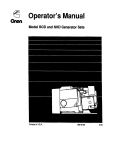
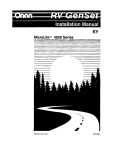
![T] .1](http://vs1.manualzilla.com/store/data/005831826_1-5c5b79be6c7f2f902c022f1ff12b7474-150x150.png)
